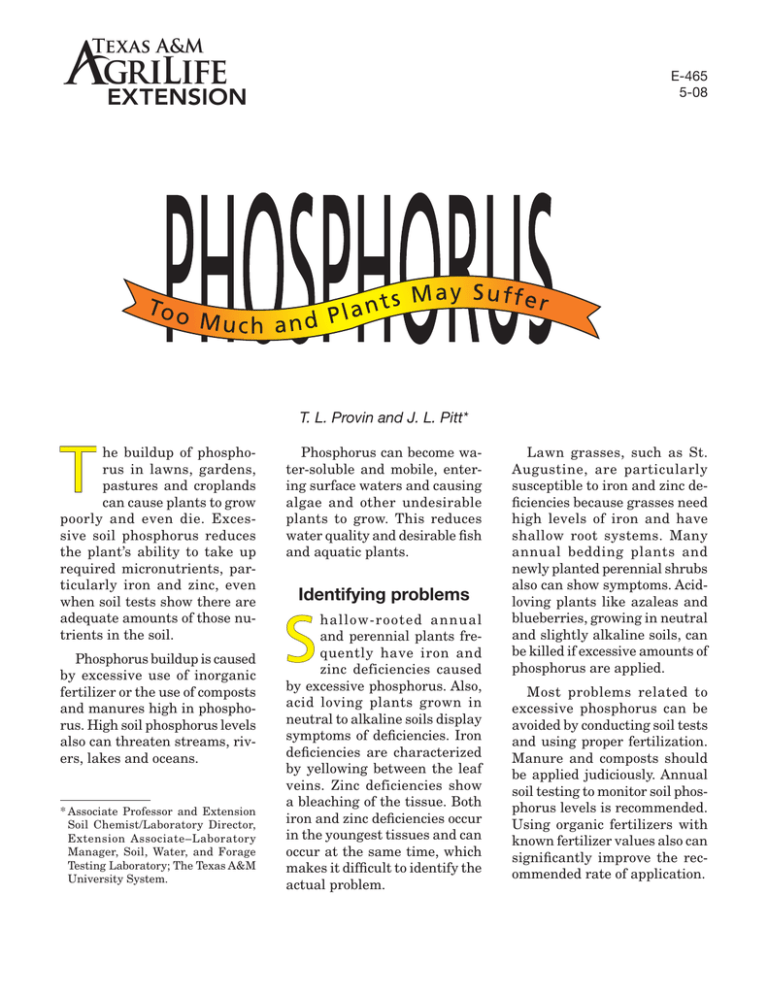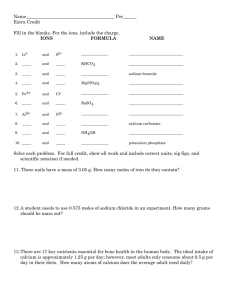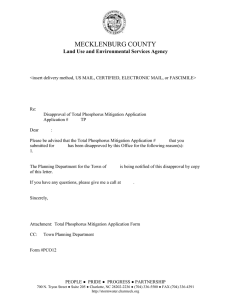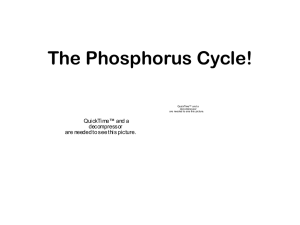T. L. Provin and J. L. Pitt*
advertisement

E-465 5-08 T. L. Provin and J. L. Pitt* he buildup of phosphorus in lawns, gardens, pastures and croplands can cause plants to grow poorly and even die. Excessive soil phosphorus reduces the plant’s ability to take up required micronutrients, particularly iron and zinc, even when soil tests show there are adequate amounts of those nutrients in the soil. Phosphorus buildup is caused by excessive use of inorganic fertilizer or the use of composts and manures high in phosphorus. High soil phosphorus levels also can threaten streams, rivers, lakes and oceans. *Associate Professor and Extension Soil Chemist/Laboratory Director, Extension Associate–Laboratory Manager, Soil, Water, and Forage Testing Laboratory; The Texas A&M University System. Phosphorus can become water-soluble and mobile, entering surface waters and causing algae and other undesirable plants to grow. This reduces water quality and desirable fish and aquatic plants. Identifying problems hallow-rooted annual and perennial plants frequently have iron and zinc deficiencies caused by excessive phosphorus. Also, acid loving plants grown in neutral to alkaline soils display symptoms of deficiencies. Iron deficiencies are characterized by yellowing between the leaf veins. Zinc deficiencies show a bleaching of the tissue. Both iron and zinc deficiencies occur in the youngest tissues and can occur at the same time, which makes it difficult to identify the actual problem. Lawn grasses, such as St. Augustine, are particularly susceptible to iron and zinc deficiencies because grasses need high levels of iron and have shallow root systems. Many annual bedding plants and newly planted perennial shrubs also can show symptoms. Acidloving plants like azaleas and blueberries, growing in neutral and slightly alkaline soils, can be killed if excessive amounts of phosphorus are applied. Most problems related to excessive phosphorus can be avoided by conducting soil tests and using proper fertilization. Manure and composts should be applied judiciously. Annual soil testing to monitor soil phosphorus levels is recommended. Using organic fertilizers with known fertilizer values also can significantly improve the recommended rate of application. Correcting problems o correct problems caused by excessive soil phosphorus, begin by avoiding future phosphorus applications. This includes eliminating organic composts and manures. If organic nitrogen sources or mulches are needed, use very low phosphorus products such as blood meal (as a nitrogen source) or pine bark mulch. Affected plants need additional iron and zinc. However, simply adding iron and zinc to the soil will not work. Research shows that soil-applied iron is rapidly tied up by alkaline soils and its availability to plants is limited. Under high phosphorus conditions, both iron and zinc are quickly converted to non-available forms. Foliar iron and zinc applications, however, work well. A number of foliar products are available at retail lawn and garden centers and through the agricultural fertilizer industry. ensure proper application rates of iron and zinc. Apply a 0.5 to 1 percent solution of both iron and zinc to the plant tissue. If a stock nutrient solution contains 10 percent iron and 10 percent zinc, one part stock nutrient solution should be mixed with nine to 19 parts water. The solution should be sprayed on plant leaves just to the point of runoff. Follow-up applications probably will be required, but timing depends on the level of deficiency, the time of year, and iron and zinc requirements of the plants being treated. In general, the solution should be applied every 1 to 4 weeks or at the first signs of deficiency. Duration of problems Use caution when spraying solutions containing iron. Any over-spray of solution may leave rust stains on sidewalks, bricks, etc. Closely follow the fertilizer label directions to ver time, phosphorus is converted to increasingly stable forms. Phosphorus eventually will be converted into “rock phosphates” that have very limited solubility except in acid soils. How long the problem persists depends on type of plants grown, soil type and the initial level of phosphorus in the soil. Soils with extractable phosphorus levels between 150 to 200 ppm (parts per million) probably will have problems for 3 to 5 years. Soils with phosphorus levels above 330 ppm will require special treatments for much longer. These timetables, currently under evaluation by the Texas AgriLife Extension Service, are only estimates and will vary considerably. Soil testing services and additional information can be obtained from the Soil, Water, and Forage Testing Laboratory at 2478 TAMU, College Station, TX 77843. Contact the lab at (979) 845-4816, Fax (979) 845-5958, or at the Web site soiltesting.tamu.edu





